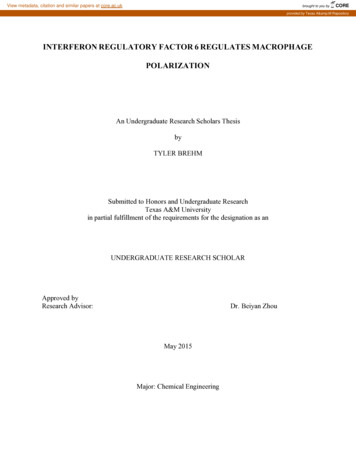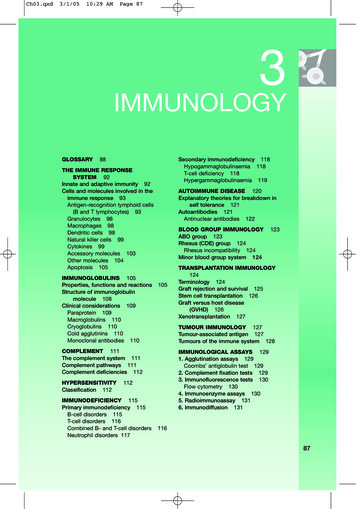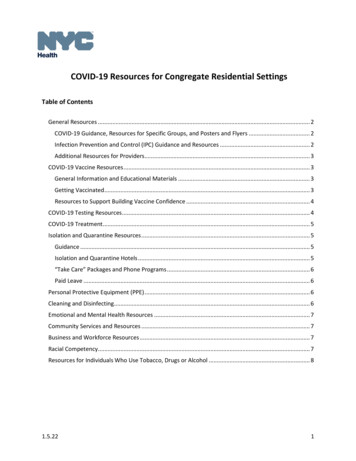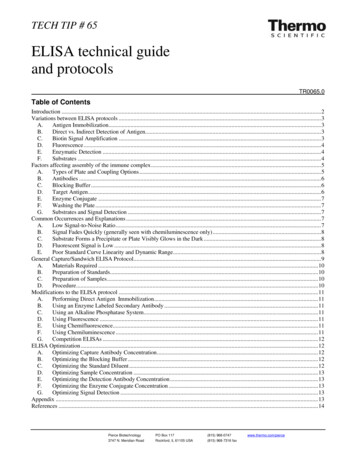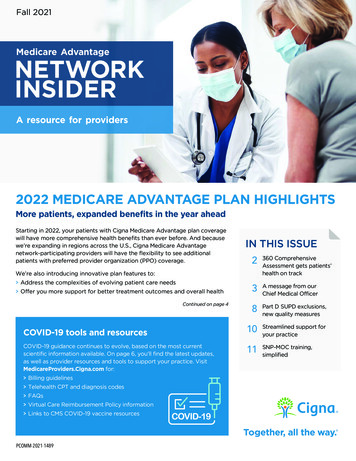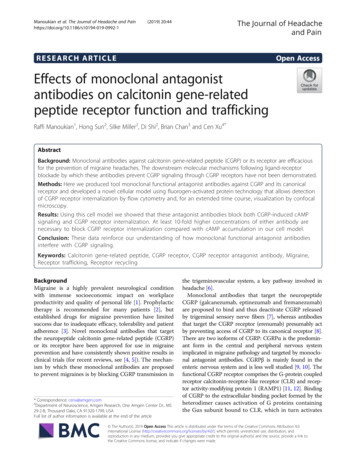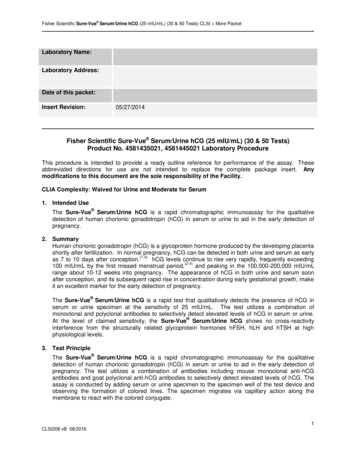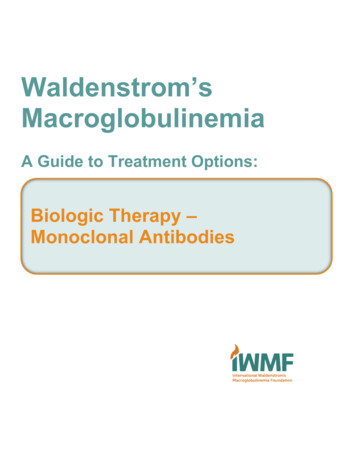
Transcription
Waldenstrom’sMacroglobulinemiaA Guide to Treatment Options:Biologic Therapy –Monoclonal Antibodies
Biologic Therapy –Monoclonal AntibodiesA Guide to Treatment OptionsIntroductionWaldenstrom’s macroglobulinemia (WM) is a lymphoma, or cancer of the lymphatic system. WM develops in atype of white blood cell called a B-lymphocyte or B-cell. B-lymphocytes typically develop into plasma cells whosejob it is to manufacture immunoglobulins (antibodies) to help the body fight infection. In WM, there is a malignantchange during the later stages of B-cell maturation that results in the development of a clone of cells. This cloneprimarily resides in the bone marrow but is often also present in the lymph nodes and spleen. These clonal cellsoverproduce an antibody of a specific class called IgM.Under the microscope, the malignant cells in WM have characteristics of both B-lymphocytes and plasma cellsand are called lymphoplasmacytic cells. For that reason, WM is classified as a type of non-Hodgkin’s lymphomacalled lymphoplasmacytic lymphoma (LPL). About 95% of LPL cases are WM. The remaining 5% do not secreteIgM and consequently are not classified as WM, but often have a similar disease course and are managed in much thesame way as WM. WM is a very rare disease – only about 1,500 patients are diagnosed with WM each year inthe US. WM is usually indolent (slow growing) and can be managed as a chronic disease for a number of years.Unfortunately, with our currently available therapies it is not yet curable.As a result of proliferation in the bone marrow, the lymphoplasmacytic cells of WM may interfere withnormal blood cell production as the WM cells “crowd out” the healthy blood cells. This may lead to a reductionin normal blood counts. Additionally, in the lymph nodes and other organs, the WM cells may lead to lymph nodeenlargement or may prevent normal function of other organs.The over-production of IgM may also cause many of the symptoms associated with the disease. IgM is a largeantibody that, unlike other types of antibodies, can bind together and form a pentamer (a group of five IgMantibodies bound together). This pentamer can make the blood thicker than normal, a condition calledhyperviscosity. Additionally, sometimes the IgM may incorrectly recognize the body’s tissues as “foreign” andattach to them, causing inflammation and injury. For example, in some patients the IgM may bind to nerves andcause damage (peripheral neuropathy) or bind to red blood cells and cause red blood cell destruction in coldtemperatures (cold agglutinin).Although a cure for WM remains elusive, continuing research has resulted in multiple treatment optionsavailable to the WM patient, and careful evaluation of all options in formal consultation with one or moreknowledgeable physicians is essential before any treatment is undertaken. Treatment recommendations needto be tailored to the individual patient, depending on the characteristics of his or her disease, as well as thepatient’s baseline medical health issues.This Treatment Options Guide is not intended to recommend any specific protocol. Such decisions must bemade with your physician and with knowledge of current treatment recommendations. Its primary purpose isto provide you with some of the information necessary to discuss treatment options intelligently with yourphysician and to make these difficult choices more easily.Unlike many cancers for which early detection and treatment are important to one’s survival, WM often,although not always, offers the luxury of time; time to seek out competent physicians and time for a secondopinion, which is always considered a good idea when one is unclear or undecided regarding a future course ofaction. A directory of physicians from around the world who are experts in WM is maintained on the IWMFwebsite at Directory of WM Physicians.Last update: 8/26/2021iwmf.com 941-927-49632
Biologic Therapy –Monoclonal AntibodiesA Guide to Treatment OptionsApproach to TreatmentThe goal of treatment for WM is to provide disease control and thereby improve quality and duration of life. ThisGuide and others in our Treatment Options series focus on drug therapies that are used for disease control.There is no single standard of therapy to treat WM; instead, there are many options available to WM patients,including the following: Chemotherapy with alkylating agents, such as cyclophosphamide and bendamustine, or withnucleoside analogs, such as fludarabine and cladribine;Biologic therapy with monoclonal antibodies such as rituximab and ofatumumab;Proteasome inhibitors such as bortezomib, carfilzomib, and ixazomib;Targeted therapies to the B-cell signaling pathways, including BTK inhibitors such as ibrutinib andzanubrutinib.Newer targeted therapies being tested (including the BCL-2 inhibitor venetoclax and the second generation BTKinhibitors acalabrutinib, pirtobrutinib, and tirabrutinib) and combinations of these drugs with older therapies arebeing added to the treatment arsenal.Some of these drugs may be used as single agents (monotherapy); however, combinations of drugs arefrequently used, and many lead to improved overall responses to therapy, either for initial (also called first-line,induction, or primary) treatment or for therapy after previously treated (relapsed) WM.Treatment is typically required when patients with WM become symptomatic and should not be initiated basedon blood test results alone. This applies not only to consideration of first-line treatment but also to treatment forrelapsed WM. Initiating treatment early in the course of the disease in most asymptomatic patients does notprolong survival and may result in a range of unpleasant or even serious side effects. Some patients may remainstable and continue to be asymptomatic for years without treatment.The following symptoms and conditions are considered appropriate reasons to begin treatment: Hyperviscosity syndrome (symptoms related to excessive thickness of the blood due to high IgM).Anemia (low red blood cell count and low hemoglobin) due to infiltration of the bone marrow withWM cells or destruction of red blood cells due to the abnormal IgM. Anemia is the most frequentcondition that leads to treatment for WM. Generally speaking, a hemoglobin level less than 10 g/dLmay be used as an indication to begin therapy.Thrombocytopenia (platelet count less than 100,000) due to bone marrow infiltration.Constitutional symptoms – weakness, fatigue, night sweats, fever, or weight loss.Systemic light-chain (AL) amyloidosis, symptomatic cryoglobulinemia, cold agglutinin disease, ormoderate to severe peripheral neuropathy. (Explanations about these conditions can be foundon the IWMF website in the Symptoms of WM section.)Bing-Neel syndrome (infiltration of WM cells into the brain, lining around the brain and/or spinal cord,or fluid surrounding the spinal cord and brain).Progressive, symptomatic enlargement of the lymph nodes, liver, or spleen.Kidney disease (nephropathy) related to WM.Masses of WM cells outside the bone marrow or pleural effusions (fluid in the chest) – treatmentis initiated based on the location, size, and rate of cell growth.Last update: 8/26/2021iwmf.com 941-927-49633
Biologic Therapy –Monoclonal AntibodiesA Guide to Treatment OptionsGiven that WM remains a very heterogeneous disease and no two patients are alike, patients and cliniciansmust decide which treatment to use based on the individual patient’s situation and disease characteristics.These may include the presence of one or more cytopenias (decreased production of blood cells); the need forrapid control of aggressive disease; age; co-morbidities (other chronic health conditions); overall health status;and candidacy for a possible autologous stem cell transplant.When immediate IgM reduction is required (such as for hyperviscosity syndrome, symptomaticcryoglobulinemia, severe hemolysis due to cold agglutinin disease, etc.), the most rapidly acting therapy isplasmapheresis, which is a procedure to withdraw plasma containing excess IgM from the blood. Afterplasmapheresis, IgM levels can be reduced significantly, but the effect is only transient, and systemic drugtherapy is required for disease control. In some cases, a surgical procedure may be needed to place a centralcatheter for plasmapheresis. More information about plasmapheresis can be found in a separate Fact Sheeton the IWMF website at IWMF & Affiliate Publications.Drug treatment can usually be administered in an outpatient setting or at home. The treatment may be givenorally, by intramuscular or subcutaneous injection, or by intravenous therapy depending on the specific therapychosen. Some treatments require that certain medications be taken the day before or the day of treatment inorder to minimize associated side effects. Traditionally, treatment may take months to complete, depending onthe course of therapy chosen. Newer targeted therapies such as ibrutinib are oral and require regular dailydosing until relapse or significant toxicities develop.Outside of clinical trials, the choice of therapy after relapse is dependent on first-line therapy use, the qualityand duration of response achieved during that therapy, and other variables such as age, tolerance of initialtherapy, candidacy for stem cell transplant, etc. Reuse of a first-line single agent therapy or combination isreasonable if a patient achieved a durable or long-lasting response; for patients who had short responses orresistance to first-line therapy, relapse therapy may consist of agents of a different class, either alone or incombination with other drugs.At the biennial International Workshops on Waldenstrom’s Macroglobulinemia (IWWM), a consensus panelof international WM experts is appointed to update recommendations for both first-line and salvage therapyin WM patients. These recommendations are developed after extensive review of published and ongoing clinicaltrials in WM. A similar set of clinical practice guidelines for treatment of WM/LPL is updated regularly by theNational Comprehensive Cancer Network (NCCN ), a not-for-profit alliance of the leading US cancer centers.The recommendations discussed in this Treatment Guide are based on both sets of guidelines.The following is a review of the targeted therapies known to affect B-cell signaling pathways. The other drugtreatment options listed above are discussed in a series of Treatment Options Guides available on the IWMFwebsite at IWMF & Affiliate Publications.Monoclonal antibodies used in WMMonoclonal antibody therapy is based on a laboratory-produced biologic molecule that is carefully engineeredto attach to a specific receptor on the surface of cells, for instance, cancer cells. Monoclonal antibodies mimicthe antibodies your body naturally produces as part of your immune system's response to infection frombacteria, viruses, and parasites and to vaccination.Last update: 8/26/2021iwmf.com 941-927-49634
Biologic Therapy –Monoclonal AntibodiesA Guide to Treatment OptionsWhen a monoclonal antibody attaches to a cell, it can make the cell more “visible” to the body’s own immunesystem and thus enables the immune system to kill the cell. Monoclonal antibodies can also be combined withradioactive particles, chemotherapy molecules, or toxins in order to deliver these cell-killing substances directlyto cancer cells, while decreasing damage to normal healthy cells that are not targeted by the monoclonalantibodies.The first monoclonal antibodies were developed from mice, but these were short-lived and not very compatiblewith human immune systems. Monoclonal antibodies in use today are chimeric (a combination of mouse andhuman antibodies that is approximately 65% human), humanized (a combination that is 95% human), or fullyhuman. All monoclonal antibody therapies are of the IgG type.Most monoclonal antibodies are administered intravenously, although a few are now being administeredsubcutaneously (under the skin). In general, monoclonal antibodies cause fewer side effects than traditionalchemotherapy drugs because they are more targeted. Typically, the most common side effects occur duringintravenous infusion when the monoclonal antibody is administered for the first time, with subsequent infusionsusually better tolerated. Infusion reaction symptoms may include headache, fever, chills, flushing, nausea, anddizziness. More severe allergic symptoms include hives, chest tightness, trouble breathing, and swelling of theface, lips, tongue, or throat. In order to minimize reactions, pre-medication with acetaminophen, antihistamine,and sometimes a corticosteroid, is standard. If a reaction is noted during the infusion, the rate of administrationcan be adjusted and more of the pre-medication drugs can be given to relieve symptoms.Rituximab (Rituxan or Mabthera)Rituximab was the first monoclonal antibody to receive FDA approval, which was for the treatment of relapsednon-Hodgkin’s lymphoma in 1998. It is prescribed off-label for WM and is now commonly used as single agenttherapy as well as in combination therapies and as maintenance therapy for both first- line andrelapsed/refractory treatment. Rituximab targets the CD20 surface antigen on B-cells.Two schedules for single agent rituximab have been studied in WM: the standard one, in which one weeklyinfusion of 375 mg/m2 is administered for four weeks; and the extended one, in which responding patientsreceive four more weekly infusions during weeks 12-16. Reported response rates vary between 25-45%.Recently, subcutaneous administration of rituximab was FDA approved for several blood cancers and mayalso be prescribed off-label for WM, although it has not been specifically studied in WM patients. The subcutaneousformulation is called Rituxan Hycela and is given by injection in 5-7 minutes rather than the typical several hoursneeded for intravenous infusion. The approval stipulates that the subcutaneous option can be used only afterpatients have received at least one treatment of rituximab intravenously. In clinical trials the effectiveness of thesubcutaneous formulation was equivalent to that of intravenous rituximab, and the side effects of subcutaneousadministration, in addition to those seen with intravenous administration, include skin issues such as rash,blistering, and peeling.About 50% of WM patients treated with rituximab experience a transient increase (greater than 25%) in serumIgM levels—referred to as the IgM “flare” phenomenon. This flare may lead to symptomatic hyperviscosity, aswell as worsening of other IgM-related conditions. Flare occurs mostly during the first 2-4 months of treatment;it is not associated with a higher risk of treatment failure, and one should be cautious not to interpret flare as alack of response or even disease progression.To avoid complications from flare, patients with symptomatic hyperviscosity or with serum IgM concentrationsLast update: 8/26/2021iwmf.com 941-927-49635
Biologic Therapy –Monoclonal AntibodiesA Guide to Treatment Optionsgreater than 4,000 mg/dL should avoid single agent rituximab when possible. If serious IgM flare during singleagent or combination treatment is considered a possibility, plasmapheresis prior to therapy should be consideredto reduce the IgM level, or rituximab should be avoided during the first one or two cycles of combination therapyuntil the IgM declines to a safer level.Rarely, patients may be intolerant to rituximab, meaning that they have worsening infusion reactions that resultin the therapy becoming unsafe. For such patients, slow infusion rates should be tried, or other drugs considered.Late-onset neutropenia (low neutrophil count) has been observed with rituximab, mostly when combined withchemotherapy. The underlying mechanism is not well understood. Reactivation of hepatitis B virus has alsobeen observed, and screening for prior hepatitis B exposure is recommended Hepatitis B carriers should beclosely monitored for clinical and laboratory signs and symptoms of active infection during therapy and forseveral months afterward.Rituximab has been combined with alkylating agents, nucleoside analogs, proteasome inhibitors, and targetedtherapies to B-cell signaling pathways. It is a part of almost every combination regimen for both first-line andrelapsed/refractory WM.Biosimilars for rituximab have been approved in Europe and the US. A biosimilar is a biological product that ishighly similar to and has no clinically meaningful difference from an existing approved reference product. Aspatent protections for rituximab and similar drugs are expiring, biosimilars are being developed to provide moretreatment options, increase access to medications, and potentially lower health care costs through competition.Although rituximab biosimilars are considered equivalent to the original product and may be prescribed offlabel for WM, they have not been specifically studied in WM patients.While rituximab maintenance therapy has been studied extensively in other blood cancers, there has beencontroversy about its role in WM. Maintenance therapy is prolonged treatment given after the initial treatmentcourse (typically combination therapy including rituximab) has resulted in a response. The rationale for its usehas been to prolong the amount of time before disease progression occurs.There is no standardized rituximab maintenance dosing schedule for WM; in clinical practice, it has varied fromone weekly infusion every two or three months to four weekly infusions every six months. The duration ofmaintenance is typically two years.A randomized Phase 3 trial of maintenance rituximab in 218 WM patients used bendamustine and rituximab asfront-line therapy. Participants who achieved at least a partial response to treatment were randomly assigned toeither two years of maintenance rituximab given every two months or to observation (no maintenance). Themedian progression-free survival in the maintenance arm of the study was 101 months and in the observationarm was 83 months; however, this difference was not statistically significant. The median overall survival hadnot yet been reached in either arm. The current IWWM consensus panel opinion is that maintenance rituximabshould not be recommended for WM patients who have achieved a partial response or better afterchemoimmunotherapy. This is based on the risk vs benefit of long-term rituximab use, which can lead to anincreased risk of infection for continuous B-cell depletion due to maintenance.Ofatumumab (Arzerra)Ofatumumab is a fully human monoclonal antibody that targets a different region on the CD20 surface antigenLast update: 8/26/2021iwmf.com 941-927-49636
Biologic Therapy –Monoclonal AntibodiesA Guide to Treatment Optionsthan rituximab. It is suggested for use in patients who are intolerant to rituximab, although infusion reactionssimilar to those from rituximab have occurred. A test dose of ofatumumab with appropriate pre-medication shouldbe considered in patients with rituximab intolerance. There is a risk of IgM flare with ofatumumab, andprecautions similar to those used for rituximab should be considered in patients who have significantly elevatedIgM levels.Obinutuzumab (Gazyva)Obinutuzumab is a humanized anti-CD20 monoclonal antibody approved for the treatment of chroniclymphocytic leukemia and follicular lymphoma. It has not been extensively studied in WM patients.AcknowledgmentsThe IWMF acknowledges the important contributions to treatment guidelines discussed here that have beenpublished by the International Workshops on Waldenstrom’s Macroglobulinemia (IWWM) and the NationalComprehensive Cancer Network (NCCN ). The IWMF also acknowledges Jorge J. Castillo, MD, of DanaFarber Cancer Institute in Boston, MA, for his medical review of this publication.About the IWMFThe International Waldenstrom’s Macroglobulinemia Foundation (IWMF) is a patient-founded and volunteer- led,nonprofit 501(c)(3) organization with an important vision, “A World Without WM,” and a mission to “Support andeducate everyone affected by WM while advancing the search for a cure.”More information about Waldenstrom’s macroglobulinemia and the services and support offered by theIWMF and its affiliate organizations can be found on our website, www.iwmf.com.The IWMF relies on donations to continue its mission, and we welcome your support. The Foundation maintainsa Business Office at 6144 Clark Center Ave., Sarasota, FL 34238. The Office can be contacted by phone at941-927-4963, by fax at 941-927-4467, or by email at info@iwmf.com.Funding provided by an unrestricted educational grant from Pharmacyclics, An AbbVie Company andJanssen Biotech, Inc.The information presented here is intended for educational purposes only. It is not meant to be a substitute for professional medicaladvice. Patients should use the information provided in full consultation with, and under the care of, a professional medical specialistwith experience in the treatment of WM. We discourage the use by a patient of any information contained here without disclosure tohis or her medical specialist.Copyright The International Waldenstrom’s Macroglobulinemia FoundationLast update: 8/26/2021iwmf.com 941-927-4963Updated August 20217
Anemia (low red blood cell count and low hemoglobin) due to infiltration of the bone marrow with WM cells or destruction of red blood cells due to the abnormal IgM. Anemia is the most frequent condition that leads to treatment for WM. Generally speaking, a hemoglobin level less than 10 g/dL may be used as an indication to begin therapy.




